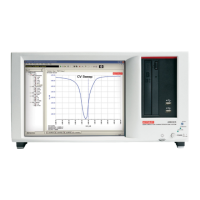2-8 Return to Section Topics 4200-900-01 Rev. K / February 2017
Section 2: Model 4200-SCS Software Environment Model 4200-SCS User’s Manual
Tests
Once the device is in position, KITE automatically conducts one or more specified tests for each
device on the test structure. Each test generates data and, if desired, parametric curves. A test
includes the following for each terminal of a device:
• The desired voltage or current forcing functions (stimuli).
• The desired voltage or current measurements.
• The associated data analyses and parameter extractions.
The combination of forcing functions and measurements is referred to as the “test definition.”
There are two classes of tests or test modules in KITE: ITMs and UTMs. Both ITMs and UTMs
share common data analysis functions, such as a Microsoft
®
Excel
®
-compatible data sheet and a
real-time graph tool.
Key differences between ITMs and UTMs include:
• Interactive test module (ITM): An ITM allows the you to define a test interactively using a
GUI and no coding.
• User test module (UTM): A UTM is defined through C programming of its connected KULT
created user module, but allows the user to configure key test parameters using a GUI.
ITMs versus UTMs
KITE tests and operations are performed through ITMs and UTMs, as shown in Figure 2-2. Figure
2-3 shows the location of the configuration windows of the vds-id ITM and the res_drain-to-
source UTM to their respective locations in the example KITE project plan.
These windows and some associated windows are examined in more detail in the next two
subsections, Defining an ITM, and Defining a UTM.
The primary differences between ITMs and UTMs are summarized in Table 2-1.
Table 2-1
Primary differences between an ITM and a UTM
ITM UTM
Is always configured using a series of systematic,
interactive GUIs, without programming.
Is created and configured by connecting the UTM
name to a user module and entering or modifying the
input parameter values.
Is flexible. Keithley Instruments provides default
ITM configurations for most standard devices and
tests; you can perform many of your evaluations
with no changes (or very few) to the default
parameters. However, you can create a new ITM,
or customize any existing ITM, to perform a wide
variety of static and dynamic evaluations. You can
even create an ITM for a generic “n-terminal”
device.
Is task-specific. However, you can modify the source
code for a user module that is connected to a UTM
and recompile it to create a new user module. Keithley
Instruments provides the source code for most of the
user modules that are shipped with the 4200-SCS.
User modules are modified using KULT.
Performs exclusively tasks on internal 4200-SCS
instrumentation.
a
a. The pulse generator card (4205-PG2) and scope card (4200-SCP2 or 4200-SCP2HR) are not supported by ITMs.
Performs tasks on internal 4200-SCS instrumentation
and external instrumentation that is connected to the
4200-SCS IEEE-488 bus or the 4200-SCS RS-232
port.
Is used exclusively for parametric testing. May be used to perform almost any test-related task.
Generated data updates the Data worksheet
b
in
real time, as the test executes.
b. Refer to the Reference Manual, Viewing ITM or UTM results numerically: The Sheet tab Data worksheet, page 6-21.
Generated data updates the Data worksheet after test
execution is complete.

